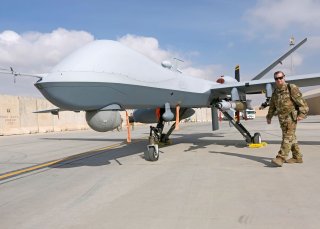How AI and Networked Drones Will Help America Wage Future Wars
Not longer just sci-fi.
As the Army looks toward future warfare scenarios, it is increasingly emphasizing the need to fully network air and ground drones to one another. This is vital as a way to fully defend advancing armored units in war and to pursue new applications of Combined Arms Maneuver.
Much of this hinges upon taking new steps with automation and AI systems to not only connect manned vehicles with air and ground drones but also extend command and control options by networking drones-to-drones in combat autonomously. Much of the work is taking place with Army Futures Command’s Artificial Intelligence Task Force in Pittsburg, Pennsylvania, which is working closely with Carnegie Mellon University.
“Up at CMU they are working on algorithms to link ground and air vehicles—and it becomes not manned-unmanned teaming but unmanned-unmanned teaming. Go out in this grid square and go identify this threat, so from a ground and air perspective, those vehicles talk to each other. We are collecting training data to train our algorithms,” General John Murray, Commanding General of Army Futures Command, told TNI in an interview.
So what would unmanned-unmanned teaming look like? What undiscovered advantages would it bring to combat? The Army is already successfully testing, developing and even deploying elements of ground and air manned-unmanned teaming. Moreover, the Army also already enables airborne helicopters to control both the flight path and sensor payload of nearby drones from the cockpit, and the service continues to make rapid progress with its Robotic Combat Vehicle program to create multiple variants of ground-combat robots.
Part of this broad unmanned system effort has also involved the use of large robotic combat vehicles being used to, for instance, breach a tank ditch with soldiers hundreds of meters away to enable follow on armored columns to more safely and effectively cross difficult terrain and advance in combat. The concept, of course, is to use forward operating drones to carry ammunition, conduct reconnaissance, breach obstacles, assist ground-attack command and control and even fire weapons when controlled by a human operator.
A new phase, would be to connect ground and air autonomous systems to one-another, as Murray indicated. In a tactical scenario, for instance, an air drone could identify maneuvering enemy formations, quickly process and disseminate combat-crucial elements from its video sensors using advanced algorithms and cue a small fleet of advancing ground drones. Such a synergy would give ground commanders an integrated air-ground combat picture in real time, massively improving attack options—all from a safer standoff distance.
A key advantage of this kind of technical advance is, simply put, speed. Ground attackers could have more vital information faster amid quick-changing landwar dynamics, without having to separately stovepipe drone sensor data at separate command and control centers or experience substantial latency. Perhaps of greatest importance, much of the data would autonomously be analyzed and organized for human decision-makers, in a matter of seconds in some instances. AI-enabled processing systems can increasingly draw upon vast databases to assess prior combat scenarios, assess a wide range of combat factors such as navigation, weather and heat signatures from enemy vehicles. This means they can perform near real-time analytics on the information and so quickly inform friendly ground forces.
For instance, a ground drone could surveil an enemy target and instantly calculate its distance, speed and various characteristics based on existing data. Imagine this kind of information being bounced off a database to quickly identify the exact threat. Or perhaps an AI system can analyze which weapons might be most effective against a certain target by virtue of performing near instant analysis of prior combat scenarios. Once many of these calculations are made autonomously, information can then transmit to an air drone which might be in a better position to attack. From there, the airborne drone would perform its own AI-enabled analytics—giving ground Commanders a nearly immediate option to destroy a moving enemy quickly.
Much of this connectivity would of course greatly expedite the Army’s push for improved air-ground-sea-cyber multi-domain operations. Murray explained that before technology can fully come to fruition, much analysis is done on conceptual shifts about combat tactics and how new techniques may change maneuver formations in war.
“Our multi-domain operations concept will transition into new doctrine to replace AirLand battle. A concept is a concept because you don’t yet have all the tools to execute it, so there are certain things related to the main operations we don’t have yet. What comes next? If technology continues to evolve at the rate it is evolving, and there are all indications that it is going to, if you look out into the future, if you don’t start thinking about it, it is going to be here before you know it and you are going to be behind,” Murray said.
Kris Osborn is the new Defense Editor for the National Interest. Osborn previously served at the Pentagon as a Highly Qualified Expert with the Office of the Assistant Secretary of the Army—Acquisition, Logistics & Technology. Osborn has also worked as an anchor and on-air military specialist at national TV networks. He has appeared as a guest military expert on Fox News, MSNBC, The Military Channel, and The History Channel. He also has a Masters Degree in Comparative Literature from Columbia University.
Image: Reuters

